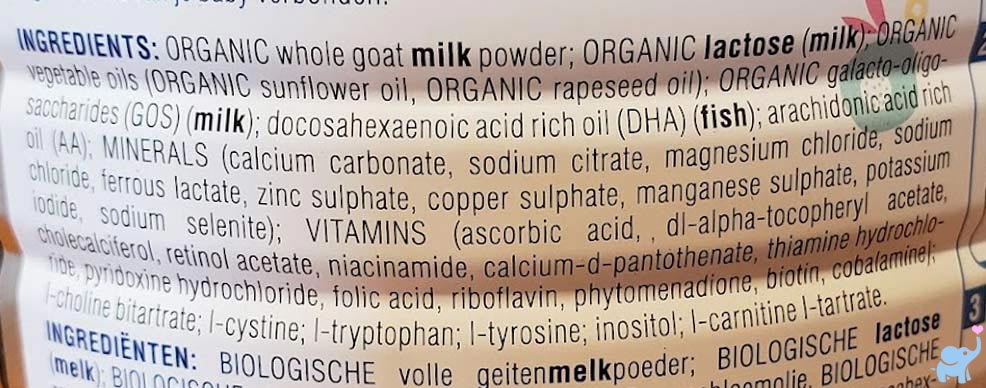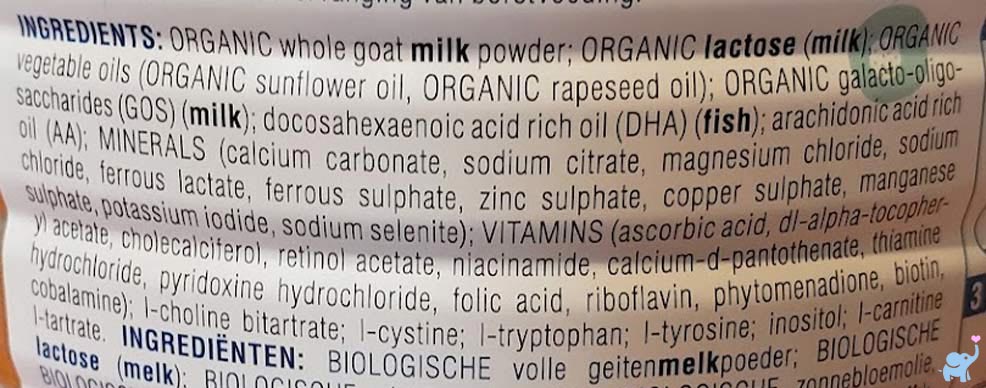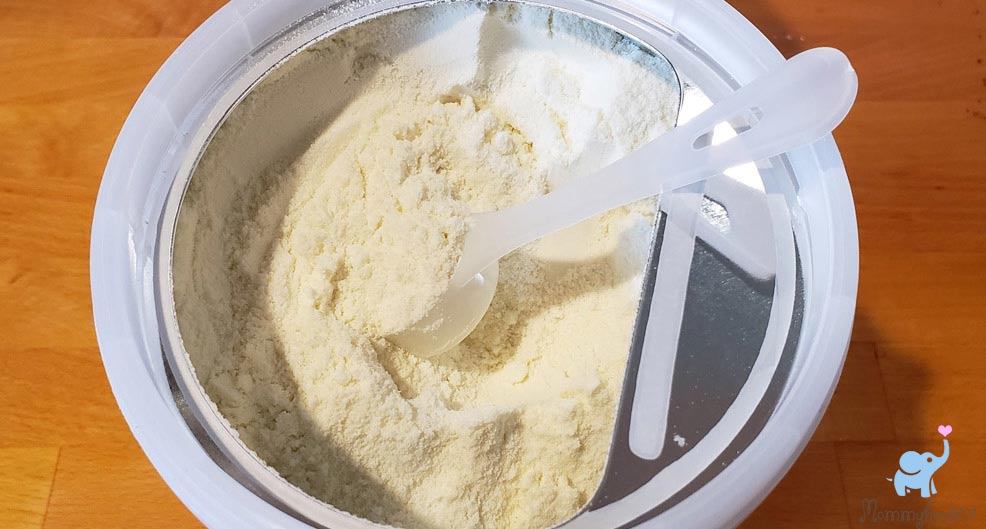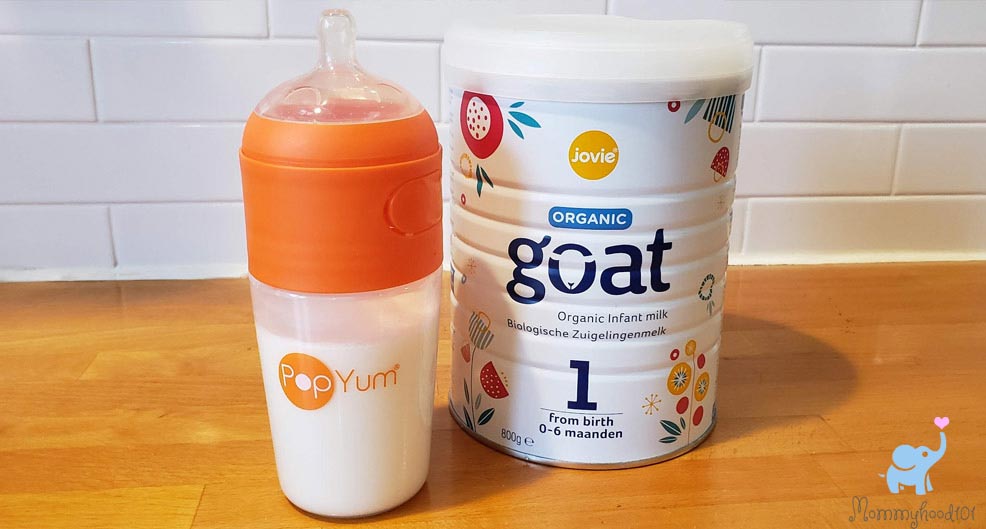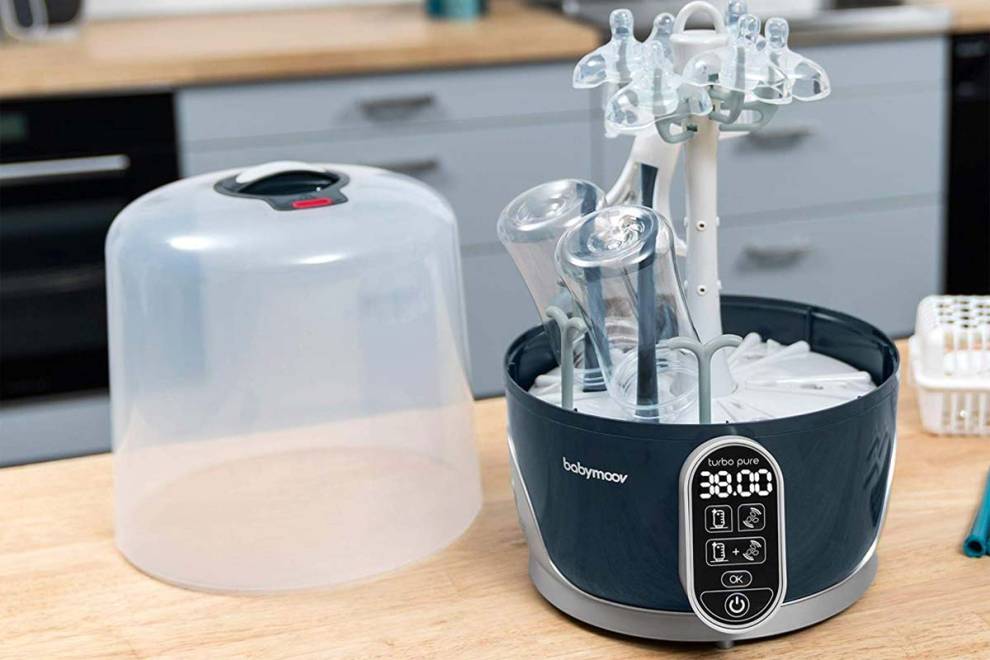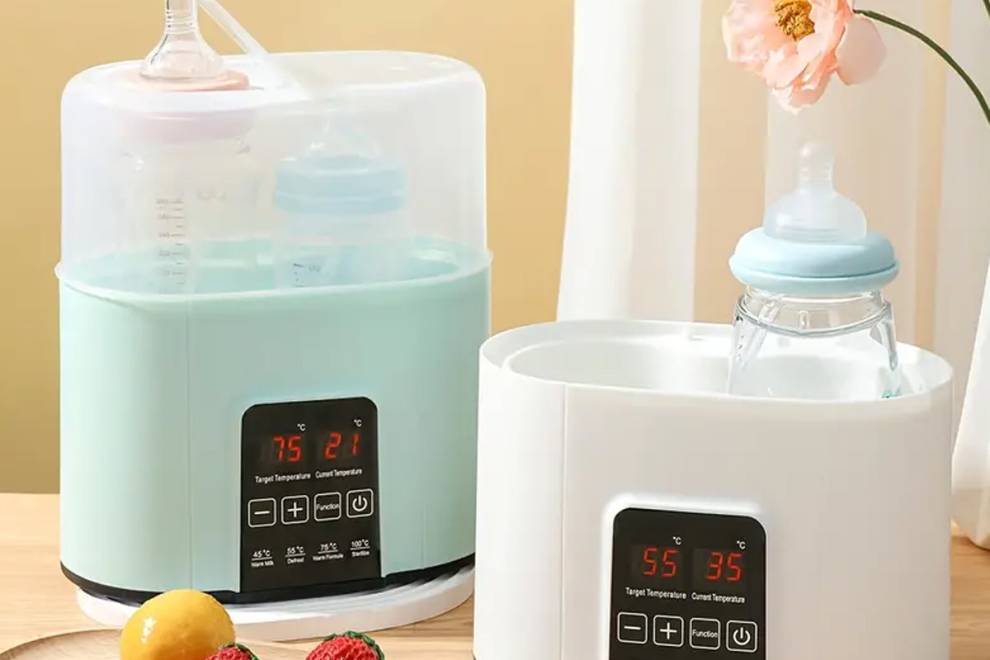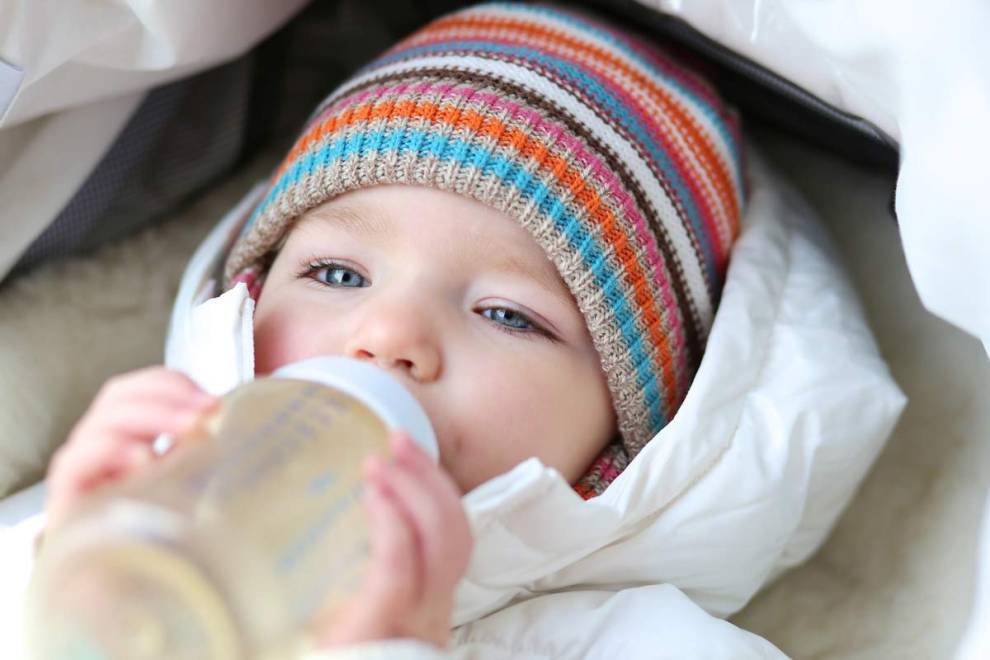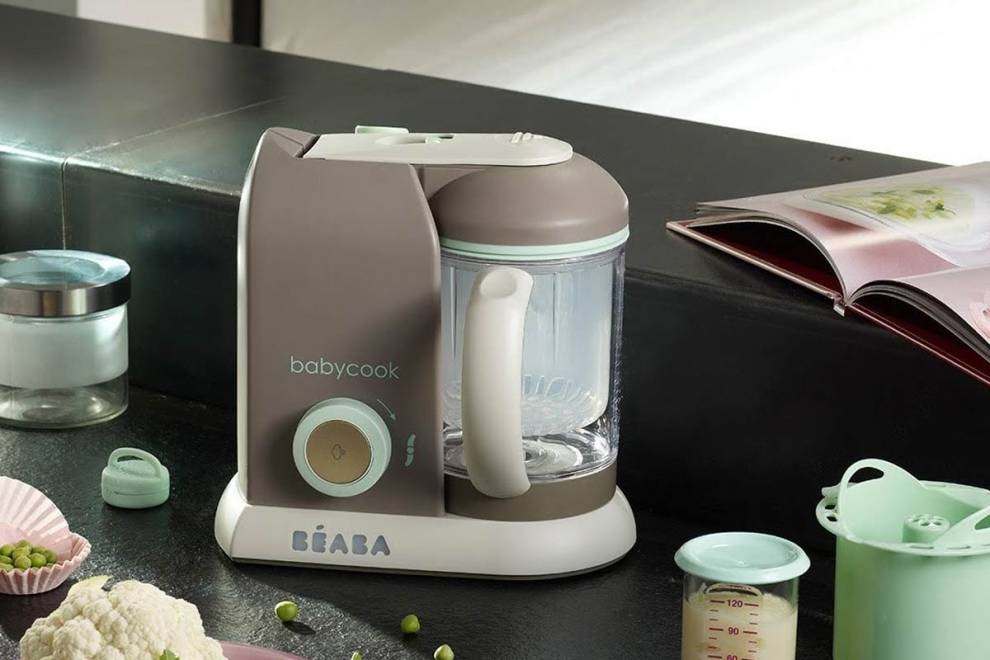We put this popular goat milk baby formula to the test, and love what we found!

Mommyhood101 independently tests and curates baby gear to help you make informed decisions. If you buy products through links on our site, we may earn a commission.
Jovie organic goat milk is becoming very popular in Europe, providing excellent nutritional composition with easily digested proteins that are great for babies with cow milk sensitivity.
Located in The Netherlands, Jovie sells three organic goat milk formulas with milk sourced only from organic (non-GMO) farms. These include Stage 1 (birth to 6 months), Stage 2 (6+ months), and Stage 3 (1+ year) options. Jovie also sells goat milk powder for big kids (3-9 years old) and even one for pregnant and lactating moms.
But how does it perform? We put it to the test to find out!
-
- Jovie Comparison Table
- Take-Home Message
- Some Translations to Know
- Jovie Farming Practices
- EU Organic Farming
- Jovie Goat Ingredients
- Jovie Stage 1 Ingredients
- Jovie Stage 2 Ingredients
- Jovie Stage 3 Ingredients
- Jovie Stages: Ingredient Differences
- Jovie Nutritional Analysis
- USDA Formula Recommendations
- Jovie Stage 1 Nutrition
- Jovie Stage 2 Nutrition
- Jovie Stage 3 Nutrition
- Jovie Testing in Infants
- Conclusions
- Where to Buy Jovie
- References Cited
Full disclosure: a leading online retailer for European baby formulas reached out to us to offer free Jovie Goat samples for testing. The samples are pictured above, provided in infant (0+ months) and two follow-on varieties (6+ months and 12+ months).
Jovie prides itself on using only organic whole goat milk and lactose, achieving stringent EU organic certification and conducting independent laboratory tests for known contaminants (such as Glyphosate), and showing consistently high performance. Be sure to also check out our Kendamil Goat formula review and Loulouka Goat formula review for more amazing non-GMO and organic goat milk formulas!
To review the Jovie organic goat milk formulas, we tested them ourselves with infants and a toddler and consulted with a developmental nutritionist to assess ingredients and nutritional contents relative to USDA guidelines.
Spoiler alert! For babies who show sensitivity to the proteins present in cow milk, Jovie is a fantastic goat milk alternative that maintains an excellent nutritional profile. Jovie has done a great job maintaining high-quality ingredients, EU (BIO) organic certification, and a well-accepted formulation that is tolerated by some very sensitive tummies. Not only is it worthy of inclusion on our list of the best organic baby formulas of the year, it motivated us to build a new list of the best goat milk formulas.
We appreciate the inclusion of omega-3 (DHA, ALA) and omega-6 (LA, AA) fatty acids, prebiotics (galactooligosaccharides, GOS), choline, inositol, and several amino acids (l-carnitine, l-choline bitartrate, l-cystine, l-tryptophan, l-tyrosine, l-tartrate). Overall, we give the Jovie Goat infant formula (Stage 1) a 4.8 out of 5, which is one of the highest we've reviewed. Keep reading to see how we reached these conclusions!
Jovie Organics Formulas: Take-home Message
Most people don't want to read this entire article to see what we found. So here is the summary of what we loved, and what we didn't.
✔️ High-quality organic formulation.
✔️ Organic EU & non-EU goat milk.
✔️ Nutrition at FDA & USDA standards.
✔️ First ingredient is whole goat milk.
✔️ Nothing artificial.
✔️ No maltodextrin or starch.
✔️ No sucrose or corn syrups.
✔️ Gluten & soy-free.
✔️ No palm, C. Cohnii, or M. Alpina oils.
✔️ Omega-3 via DHA & ALA.
✔️ Omega-6 via LA & AA.
✔️ Inositol & Choline (stages 1-2).
✔️ Amino Acids.
✔️ High infant acceptance, good taste.
✔️ No gas, indigestion, or constipation.
✔️ Prebiotics via GOS.
❌ No probiotics.
Jovie Formulas: Some Translations
Because Jovie products are made in The Netherlands and labeled for sale in the EU, the labels are in both Dutch and English.
That means there is no translation required, which makes life much easier than with some other European options.
Here are some key terms from the packaging and their translations:
Biologische Zuigelingenmelk: Biologishe means organic, Zuigelingen means infants, and Melk means milk. Together, this means organic infant milk.
Geit: Just for fun, Geit (pronounced like "height") means goat!
Maanden: This means months in Dutch, so when it says "0+ maanden" that means 0+ months.
Of course, all of this is also printed in English on the label, so you won't need to worry about remembering this first lesson in Dutch!
Jovie Formulas: Best Practices?
Jovie formulas are made in The Netherlands using organic ingredients sourced from throughout EU and non-EU countries.
Jovie is certified organic (Bio) in the EU with the code NL-BIO-01, which indicates that the product was inspected and certified by Skal Biocontrole, located in the northeastern Netherlands (in a city named Zwolle).
We did some research into the sourcing of the milk ingredients, based on the code on the side of the tin (NL Z0526 EC). This code indicates the plant where the formula was made, in this case, a plant in Zwolle owned by a company named Buisman Zwolle B.V., which makes infant formula and milk powders. This specific facility holds several certifications, including organic, kosher, halal, and the Scheme for Food Safety Management Systems (FSSC 22000).
Relative to the USDA Organic certification process used in the USA (see the familiar logo on the right), the European Union (including The Netherlands) has stricter organic regulations. Once you receive approvals through the extended certification process, you can display the below (center) star leaf icon on your products.
By comparison, Jovie meets the 98% minimum organic content requirement of the EU requirement, which is a bit more stringent than the 95% minimum organic content requirement of the USDA's certification process.
What are the EU's organic regulations?
Because Jovie Organics sells their baby formulas primarily to the Netherlands market, and The Netherlands is part of the European Union, they must conform to EU organic requirements.
Fortunately for you, the EU has a very strict system of organic controls, including a rigorous annual inspection process to verify continuing conformance.
Here are the specific organic regulatory criteria for the EU certification process:
- No protecting plants by using synthetic chemicals such as herbicides or pesticides.
- No use of soluble mineral fertilizers.
- No application of chemical growth regulators.
- Feeding animals with farm-grown feed, not purchased feed, when possible.
- No use of antibiotics other than to treat an infection.
Jovie Formula Ingredients
The ingredient sourcing for Jovie is not as transparent as it is for other brands (such as Löwenzahn formulas), but the label indicated that the ingredients were sourced from EU and non-EU agriculture. We are going to assume that the goat milk and lactose are sourced primarily from the EU and other parts of Europe, and possibly from other regions such as South Africa.
The use of ingredients sourced from organic farms in Europe provides some intangible benefits for the quality of infant and toddler formulas, but we cannot guarantee that is the case with these ingredients. While these benefits may not appear on an ingredients label, this usually means that there is a lower risk of the products containing all the nasty stuff you don't want to occur (even in trace amounts), like pesticides, herbicides, antibiotics, or heavy metals.
Here are the ingredients in each of the Jovie baby formulas (as of late 2021 manufacturing date):
Jovie Stage 1 Ingredients: organic whole goat milk powder, organic lactose (milk), organic vegetable oils (organic sunflower oil, organic rapeseed oil), organic gelato-oligosaccharides (GOS) (milk), docosahexaenoic acid rich oil (DHA) (fish), arachidonic acid-rich oil (AA), minerals (calcium carbonate, sodium citrate, magnesium chloride, sodium chloride, ferrous lactate, zinc sulfate, copper sulphate, manganese sulphate, potassium iodide, sodium selenite), vitamins (ascorbic acid, dl-alpha-tocopheryl acetate, cholecalciferol, retinol acetate, niacinamide, calcium-d-pantothenate, thiamine hydrochloride, pyridoxine hydrochloride, folic acid, riboflavin, phytomenadione, biotin, cobalamine), l-choline bitartrate, l-cystine, l-tryptophan, l-tyrosine, inositol, l-carnitine, l-tartrate.
Note: sunflower oil contains linoleic acid (LA), and rapeseed oil contains both linoleic and α-linolenic acid (LA, ALA).
Jovie Stage 2 Ingredients: organic whole goat milk powder, organic lactose (milk), organic vegetable oils (organic sunflower oil, organic rapeseed oil), organic gelato-oligosaccharides (GOS) (milk), docosahexaenoic acid rich oil (DHA) (fish), arachidonic acid rich oil (AA), minerals (calcium carbonate, sodium citrate, magnesium chloride, sodium chloride, ferrous lactate, ferrous sulphate, zinc sulfate, copper sulphate, manganese sulphate, potassium iodide, sodium selenite), vitamins (ascorbic acid, dl-alpha-tocopheryl acetate, cholecalciferol, retinol acetate, niacinamide, calcium-d-pantothenate, thiamine hydrochloride, pyridoxine hydrochloride, folic acid, riboflavin, phytomenadione, biotin, cobalamine), l-choline bitartrate, l-cystine, l-tryptophan, l-tyrosine, inositol, l-carnitine, l-tartrate.
Note: sunflower oil contains linoleic acid (LA), and rapeseed oil contains both linoleic and α-linolenic acid (LA, ALA).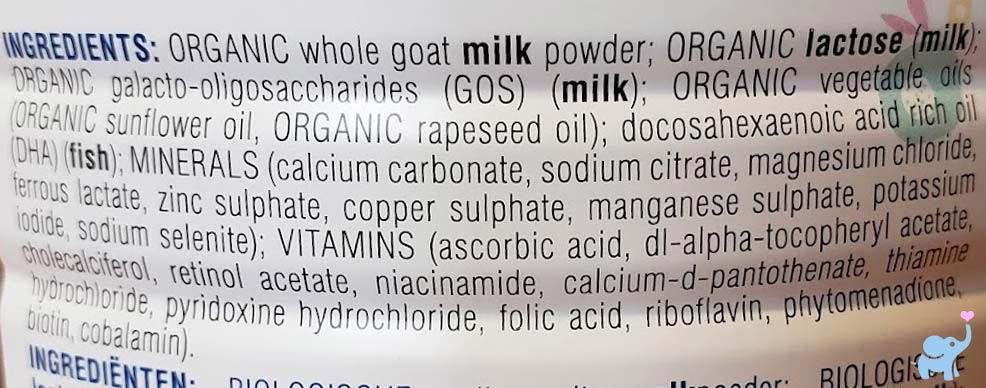
Jovie Stage 3 Ingredients (translated): organic whole goat milk powder, organic lactose (milk), organic gelato-oligosaccharides (GOS) (milk), organic vegetable oils (organic sunflower oil, organic rapeseed oil), docosahexaenoic acid rich oil (DHA) (fish), minerals (calcium carbonate, sodium citrate, magnesium chloride, ferrous lactate, zinc sulfate, copper sulphate, manganese sulphate, potassium iodide, sodium selenite), vitamins (ascorbic acid, dl-alpha-tocopheryl acetate, cholecalciferol, retinol acetate, niacinamide, calcium-d-pantothenate, thiamine hydrochloride, pyridoxine hydrochloride, folic acid, riboflavin, phytomenadione, biotin, cobalamine).
Here are some ingredients that we did not find in any stages of Jovie: corn syrup or corn syrup solids, artificial colors, artificial flavors, preservatives, sucrose, soy, gluten, genetically modified organisms (GMOs), palm oil, starch, maltodextrin, carrageenan, or high fructose corn syrup.
Some ingredients we didn't appreciate:
Well, this is awkward - we liked all the ingredients!
Several baby formulas have ingredients that we don't appreciate such as palm oil, maltodextrin, starch, C. Cohnii oil, M. Alpina Oil, and more.
But not Jovie, they get a pretty clean bill of health!
Some parents may not appreciate the use of fish oil as a DHA source; however, we prefer it to the other options, especially when we cannot taste any trace of fish in the prepared formula.
Some other ingredients worth mentioning:
Prebiotics via GOS: These are galactooligosaccharides, which are dietary prebiotics that help promote a healthy gut microbiome through benefits to intestinal microbiota and gut barrier function. Research shows that prebiotics in infant formula is beneficial for digestion and reducing the rates of gas and colic (and they are more effective than probiotics, see references).
Fluoride: Jovie doesn't add fluoride to their formulas like some others (like we saw in our Kendamil formula review), though it is naturally present in small amounts, just like it is with most goat milk formulas, as seen in our Kabrita infant formula review.
Jovie Stages: Ingredient Differences
1. Jovie Stage 1 versus Stage 2: There are two main differences between Jovie Stages 1 and 2. First, Stage 2 adds a bit more iron in the form of ferrous sulphate, which shows high bioavailability; increasing iron in Stage 2 makes sense given that the highest rates of anemia in children begin around 6 months of age (see references). The second difference is that Stage 2 has slightly less fat than Stage 1, about 3% less, but also has slightly more protein (about 8% more).
2. Jovie Stage 2 versus Stage 3: There are three main differences between Jovie Stages 2 and 3. First, Stage 3 adds more prebiotics than Stage 1 and reduces the fat content by about 6% relative to Stage 2. Second, Stage 3 no longer includes arachidonic acid (AA, an Omega-6), and also drops several amino acids (l-choline bitartrate, l-cystine, l-tryptophan, l-tyrosine, inositol, l-carnitine, l-tartrate). Finally, Stage 3 dramatically increases the protein content by about 57% relative to Stage 2. This is appropriate to have a higher protein-to-fat and protein-to-carbohydrate ratio as your child gets older.
Jovie Formula Nutritional Analysis
To examine whether Jovie baby formulas come close to the stringent US nutritional recommendations put forth by the US Department of Agriculture (USDA, see references), Food and Drug Administration (FDA), and American Academy of Pediatrics (AAP), we consulted with a dietician nutritionist with expertise in infant feeding (Mr. John Anderson).
Note that the FDA publishes guidance in 21 U.S. Code 350a regarding nutrient requirements in infant formula. This regulation includes minimum protein and fat (and fatty acid linoleate) content. It also includes standardized ranges for 15 vitamins and 11 minerals.
Here are the FDA requirements per 100 kilocalories of formula (see references):
FDA Nutritional Requirements:
| Protein | 0-6mo: 1.8g to 4.5g |
| Fat | 0-6mo: 3.3g to 6.0g (≥ 30% of calories) |
| Essential Fatty Acid (LA Omega-6) | 0-6mo: ≥300mg (≥2.7% of calories) |
| Vitamin A | 0-6mo: 250IU to 750IU (75-225μg if retinol) |
| Vitamin D | 0-6mo: 40IU to 100IU |
| Vitamin K | 0-6mo: ≥4μg |
| Vitamin E | 0-6mo: 0.7IU |
| Vitamin C | 0-6mo: ≥8mg |
| Vitamin B1 | 0-6mo: ≥40μg |
| Vitamin B2 | 0-6mo: ≥60μg |
| Vitamin B6 | 0-6mo: ≥35μg |
| Vitamin B12 | 0-6mo: ≥0.15μg |
| Niacin | 0-6mo: ≥250μg |
| Folic Acid | 0-6mo: ≥4μg |
| Pantothenic Acid | 0-6mo: ≥300μg |
| Biotin | 0-6mo: ≥1.5μg (for non-milk-based formulas) |
| Choline | 0-6mo: ≥7mg (for non-milk-based formulas) |
| Inositol | 0-6mo: ≥4mg (for non-milk-based formulas) |
| Calcium | 0-6mo: ≥50mg |
| Phosphorus | 0-6mo: ≥25mg |
| Magnesium | 0-6mo: ≥6mg |
| Iron | 0-6mo: ≥0.15mg |
| Iodine | 0-6mo: ≥5μg |
| Zinc | 0-6mo: ≥0.5mg |
| Copper | 0-6mo: ≥60μg |
| Manganese | 0-6mo: ≥5μg |
| Sodium | 0-6mo: 20mg to 60mg |
| Potassium | 0-6mo: 80mg to 200mg |
| Chloride | 0-6mo: 55mg to 150mg |
In our review of the Jovie Stage 1 formula, using a 1.515 multiplier relative to their nutrition facts label (to equal 100kcal of formula), we found that the Jovie Stage 1 infant formula met all of the minimum FDA nutritional requirements (and did not exceed any of their maximums).
The USDA does not publish recommended daily allowances (RDAs) for infants between 0-6 months. Instead, they publish information about Adequate Intake (AI), which is used when there is not enough evidence to make a formal RDA. The AI is set at a level assumed to provide nutritional adequacy.
Here are the USDA's AIs (per day) for infants aged 0-6 months, and 6-12 months. Units are grams (g), milligrams (mg), and micrograms (μg).
USDA Nutritional Recommendations:
| Carbohydrates | 0-6mo: 60g | 6-12mo: 95g |
| Proteins | 0-6mo: 9.1g | 6-12mo: 11g |
| Fats | 0-6mo: 31g | 6-12mo: 30g |
| Omega-3 | 0-6mo: 0.5g | 6-12mo: 0.5g |
| Omega-6 | 0-6mo: 4.4g | 6-12mo: 4.6g |
| Vitamin A | 0-6mo: 400μg | 6-12mo: 500μg |
| Vitamin B1 | 0-6mo: 0.2mg | 6-12mo: 0.3mg |
| Vitamin B2 | 0-6mo: 0.3mg | 6-12mo: 0.4mg |
| Vitamin B6 | 0-6mo: 0.1mg | 6-12mo: 0.3mg |
| Vitamin B12 | 0-6mo: 0.4μg | 6-12mo: 0.5μg |
| Vitamin C | 0-6mo: 40mg | 6-12mo: 50mg |
| Vitamin D | 0-6mo: 5μg | 6-12mo: 5μg |
| Vitamin E | 0-6mo: 4mg | 6-12mo: 5mg |
| Vitamin K | 0-6mo: 2μg | 6-12mo: 2.5μg |
| Folate | 0-6mo: 65μg | 6-12mo: 80μg |
| Niacin | 0-6mo: 2mg | 6-12mo: 4mg |
| Calcium | 0-6mo: 210mg | 6-12mo: 270mg |
| Iron | 0-6mo: 0.27mg | 6-12mo: 11mg |
Given that the Stage 1 Jovie formula is intended for use from birth to 6 months, we evaluated its nutritional content against the USDA 0-6 month recommendations. For the Stage 2 and 3 versions, we evaluated against the USDA 6-12 month recommendations.
Because the USDA recommendations are for daily intake, we considered the daily intake recommended by Jovie in their "Feeding Guide". Stage 1 suggests an average of about 110 grams of formula per day for the first 6 months; of course, this is lower (about 80 grams) for the first month, then increases with age to over 120g/day.
To derive an estimate of how much nutritional content a baby would receive each day when using Jovie Organic Stage 1, we used the average recommended serving for the first 6 months (about 110 grams of formula per day). This will overestimate nutrients in the early months, and underestimate them in later months. As you will see from our analysis, this isn't cause for much concern.
Does Jovie Stage 1 Meet USDA Nutritional Recommendations?
In general, yes, very similar to US-made baby formulas. Here is a table comparing the USDA recommendation for 0-6 months to what the Jovie Stage 1 provides (in about 110g of powdered formula):
| Carbohydrates | USDA: 60g | Stage 1: 60.4g |
| Proteins | USDA: 9.1g | Stage 1: 11.1g |
| Fats | USDA: 31g | Stage 1: 29.8g |
| Omega-3 | USDA: 0.5g | Stage 1: 0.54g |
| Omega-6 | USDA: 4.4g | Stage 1: 4.2g |
| Vitamin A | USDA: 400μg | Stage 1: 425μg |
| Vitamin B1 | USDA: 0.2mg | Stage 1: 0.42mg |
| Vitamin B2 | USDA: 0.3mg | Stage 1: 0.7mg |
| Vitamin B6 | USDA: 0.1mg | Stage 1: 0.31mg |
| Vitamin B12 | USDA: 0.4μg | Stage 1: 1.7μg |
| Vitamin C | USDA: 40mg | Stage 1: 128mg |
| Vitamin D | USDA: 5μg | Stage 1: 12.8μg |
| Vitamin E | USDA: 4mg | Stage 1: 11.9mg |
| Vitamin K | USDA: 2μg | Stage 1: 28.1μg |
| Folate | USDA: 65μg | Stage 1: 93.5μg |
| Niacin | USDA: 2mg | Stage 1: 2.8mg |
| Calcium | USDA: 210mg | Stage 1: 536mg |
| Iron | USDA: 0.27mg | Stage 1: 5.1mg |
Notice how close all of those numbers are to each other, with Jovie showing a very similar nutritional profile to most other European baby formulas, prioritizing protein over fats. Specifically, European formulas tend to have slightly higher protein and slightly lower fat than American baby formulas.
USDA guidance for fat is 31g per day, which precisely matches how much fat is in breast milk (about 4.2g per 100mL, or 30.8g per 100g). Jovie comes in at about 30g/day, which is similar to Kendamil but actually higher than most European baby formulas such as Loulouka, HiPP Combiotic, or Holle Stage 1.
We also compared the Jovie Stage 1 nutritional profile with the most popular Similac and Enfamil (American) formulas. Those brands are usually slightly low relative to those USDA recommendations (Similac and Enfamil are usually around 27g of fat per 100g of formula).
In other words, Jovie Stage 1 provides an overall nutritional profile that is very similar to the major American baby formula brands, but with a slight prioritization of proteins over fats - this is common for European baby formulas.
Does Jovie Stage 2 Meet USDA Nutritional Recommendations?
In looking at the USDA recommendations for infants 6-12 months of age, you realize that they recommend about 140-150g/day of formula. That equates to about 34 scoops (4.3g/scoop) per day, which is about 1115mL per day of the prepared Stage 2 formula.
Clearly, that's a ton of formula and unlikely to be the case with your 6-12-month-old baby since you'll likely be supplementing formula with at least some oatmeal and/or rice cereal.
Here is a table comparing the USDA recommendation for 6-12 months to what the Jovie Stage 2 provides (in 150g of powdered formula):
| Carbohydrates | USDA: 95g | Stage 2: 82.1g |
| Proteins | USDA: 11g | Stage 2: 16.2g |
| Fats | USDA: 30g | Stage 2: 40.5g |
| Omega-3 | USDA: 0.5g | Stage 2: 0.73g |
| Omega-6 | USDA: 4.6g | Stage 2: 5.6g |
| Vitamin A | USDA: 500μg | Stage 2: 578μg |
| Vitamin B1 | USDA: 0.3mg | Stage 2: 0.6mg |
| Vitamin B2 | USDA: 0.4mg | Stage 2: 0.9mg |
| Vitamin B6 | USDA: 0.3mg | Stage 2: 0.4mg |
| Vitamin B12 | USDA: 0.5μg | Stage 2: 2.32μg |
| Vitamin C | USDA: 50mg | Stage 2 173.4mg |
| Vitamin D | USDA: 5μg | Stage 2: 17.3μg |
| Vitamin E | USDA: 5mg | Stage 2: 16.2mg |
| Vitamin K | USDA: 2.5μg | Stage 2: 38.2μg |
| Folate | USDA: 80μg | Stage 2: 127μg |
| Niacin | USDA: 4mg | Stage 2: 3.8mg |
| Calcium | USDA: 270mg | Stage 2: 728mg |
| Iron | USDA: 11mg | Stage 2: 10.4mg |
For Stage 2, the Jovie comes in over the protein and fat recommendations of USDA, and under the carbohydrate recommendation. In other words, the Stage 2 formula is shifting towards a higher protein and fat diet, with lower sugars.
The only other noticeable difference is that the Jovie Stage 2 has slightly low niacin and iron; of course, if you begin to supplement with cereals (oatmeal, rice) and other baby foods, these gaps should be easily filled.
From 0-6 months to 6-12 months, the USDA shifts the relative proportion of carbohydrates up, and proteins and fats down. This is a difference in European versus American feeding recommendations, with proportions shifting in opposite directions as babies move from Stage 1 to Stage 2.
Which is the right guideline to follow? Our opinion is that the EU standards are more in line with current research, whereas the USDA guidelines are relatively dated. But that's just an opinion, and research is constantly changing!
Does Jovie Stage 3 Meet USDA Nutritional Recommendations?
As with Stage 2, we use the USDA 6-12 month recommendations. Stage 3 is always a difficult comparison to make because your child will also be eating many first foods (oatmeal and rice cereals, purees) by the time they are 12+ months. Those solid foods will complement any feeding done with a Stage 3 formula, making any estimates of formula quantity to fulfill the caloric needs of a 12+ month-old baby a bit unreasonable.
For example, to get 145g/day of Stage 3 formula, that would take about 32 scoops of the product, and over 1070mL of prepared formula per day (about 5 servings). That's pretty excessive! More reasonably, your child will be consuming about 2-3 servings of Stage 3, along with a couple of servings of cereals and purees.
In any event, here is what Jovie Stage 3 provides, at a 150g/day serving:
| Carbohydrates | USDA: 95g | Stage 3: 76.7g |
| Proteins | USDA: 11g | Stage 3: 24.4g |
| Fats | USDA: 30g | Stage 3: 35.6g |
| Omega-3 | USDA: 0.5g | Stage 3: 0.48g |
| Omega-6 | USDA: 4.6g | Stage 3: 2.9g |
| Vitamin A | USDA: 500μg | Stage 3: 589μg |
| Vitamin B1 | USDA: 0.3mg | Stage 3: 0.61mg |
| Vitamin B2 | USDA: 0.4mg | Stage 3: 1.0mg |
| Vitamin B6 | USDA: 0.3mg | Stage 3: 0.44mg |
| Vitamin B12 | USDA: 0.5μg | Stage 3: 2.2μg |
| Vitamin C | USDA: 50mg | Stage 3: 100mg |
| Vitamin D | USDA: 5μg | Stage 3: 16.7μg |
| Vitamin E | USDA: 5mg | Stage 3: 14.4mg |
| Vitamin K | USDA: 2.5μg | Stage 3: 39μg |
| Folate | USDA: 80μg | Stage 3: 122μg |
| Niacin | USDA: 4mg | Stage 3: 4.4mg |
| Calcium | USDA: 270mg | Stage 3: 1022mg |
| Iron | USDA: 11mg | Stage 3: 12.2mg |
In terms of macronutrients (proteins, fats, carbohydrates), you'll notice that Stage 3 is very similar to Stage 2 in its nutritional composition and proportions. In general, it meets USDA recommendations but prioritizes proteins and fats rather than carbohydrates, which is the opposite of the American tendency to prioritize carbohydrates over proteins and fats.
In 2020, the EU passed (well, it was passed in 2016, but enforcement started in February 2020) a requirement that baby formulas include Omega-3, and this is a new addition to most European formulas. This is why you see DHA and ALA appearing in new European formulas.
Most parents begin solid foods in addition to formula or breastfeeding. These usually first include rice and/or oatmeal cereals and then progress to fruit and vegetable purees. These will complement the nutrition found solely in the formula, including additional iron and carbohydrates.
Some parents might be interested to learn that many European baby formulas contain trace levels of fluoride. This is not usually added by the manufacturer but appears in trace amounts (e.g., <0.001mg per 100mL prepared formula) due to the water used during manufacturing. For Jovie, this occurs in all three stages.
The level of fluoride (about 0.007 mg in 13.2g of powder) in Jovie is equivalent to about 0.7 mg of fluoride in a liter of prepared formula, which is similar to fluoride levels found in bottled water (about 0.4mg per liter), and way less than found in typical (fluoridated) tap water (about 5mg per liter).
Jovie Testing in Infants
Jovie was generous enough to donate Stage 1, Stage 2, and Stage 3 varieties of their organic formula for testing!
We tested Stage 1 in a newborn (5 weeks) breastfed baby and a 3-month-old formula-fed baby (he typically feeds with HiPP Combiotic).
We tested Stage 2 in an 11-month-old formula-fed baby (Similac). Finally, we tested Stage 3 in an 18-month-old toddler who was no longer breastfeeding.
Mixing and Taste-Testing
Jovie mixes very easily with warm water (they say to use water at about 104 degrees F), and we found that it didn't leave any film, residue, or clumps on the inside of the bottle. Not only that, but we didn't experience any bubbling or foaming after vigorous shaking. That's very rare, and we love to see a formula powder mix so easily with water!
To prepare the formula, we followed the instructions: fill the bottle with the correct amount of water (e.g., 180ml), then add the number of level scoops to the water. You can use the clever edge on the inside of the formula can to level the scoop (as seen in the below photo).
Next, close the bottle and shake carefully until the powder is fully mixed into the water.
Verify it is cooled to about 99 degrees F (37 deg C), and feed!
In terms of texture and taste, we didn't experience any grainy texture and thought the formula was smooth and rich. The flavor was nice and sweet without being overpowering, likely due to the high lactose content.
Personally, we're not huge fans of drinking goat milk as adults, but honestly, this tasted nothing like goat milk, which was a pleasant surprise!
The prepared formula had very good flow through slow-flow or medium-flow nipples.
Notice how the bubbles and foam settled very nicely after mixing and sitting for a few minutes to cool to around 99deg F? Want to learn more about that PopYum bottle? Check out our list of the Best Baby Bottles of the year!
Safety First: Never prepare powdered formula with anything but water. If you're interested in fortifying your breast milk with formula you must ask your doctor for guidance first, as this can be very dangerous for your baby.
Feeding with Jovie
The two infants both seemed to appreciate the flavor and texture of Jovie and took the bottle without any issues. Both moms were a little nervous to try goat milk for the first time, but both were pleasantly surprised with the quality, taste, and acceptance.
In the short- and long-term, neither of the infants developed any apparent gas or indigestion (or spit up!), at least not more so than their usual levels.
The older baby, at 11 months, tested the Stage 2 (6+ months) version. She was hesitant at first about the taste but then seemed perfectly fine with it. Her mom noted that she's very picky about her formula (currently using a Similac variety), so she was surprised to see her accept it without putting up too much of a fuss!
Finally, we tested Stage 3 in an 18-month-old boy who was no longer breastfeeding; he seemed to be indifferent about it, trying some and then leaving it aside while he ate his Goldfish!
Conclusions
This was our first time trying out the new Jovie Goat Milk Formula and we were really excited to give it a shot!
It's the first goat milk formula we've tried here at Mommyhood101, and we were pleasantly surprised by the quality, taste, and acceptance among our test babies.
The goat milk formula market is growing quickly (see our recent Kendamil goat formula review and Nannycare formula reviews!), especially among parents looking for an alternative to cow's milk to help satisfy more sensitive tummies or avoid allergies.
Jovie goat milk combines the relatively easy-to-digest goat milk protein (A2 beta-casein) with the full-fat goodness of a formula like Kendamil. Note that Jovie goat milk formula still contains lactose, which is the most prevalent carbohydrate in breast milk, so it is not suitable for babies with lactose intolerance (or with a real cow milk allergy).
Always talk to your child's doctor before switching to goat milk or selecting a formula for your little one.
In the near future, we will expand our reviews of goat milk formulas and pull together a round-up article to rank our recommendations.
In the meantime, we are very happy to report that we appreciated nearly everything about the Jovie formulas!
They met the USDA and FDA guidelines for nutritional content, they use high-quality manufacturing and meet the stringent EU organic certifications, the formula was easy to prepare and feed, it tasted great (to us! including no fishy flavor) and it was accepted by all of our newborn and infant testers.
That's a pretty fantastic result, not to mention that none of them showed any sign of GI upset (gas, indigestion, spit-up, constipation).
Expensive? Yes. All baby formula is expensive, and Jovie and other European formula brands are among the most expensive on the market.
Where to Buy Jovie Goat Formula?
Over the past 10+ years of operating Mommyhood101, we have worked with several companies that import and resell European baby formulas in the United States.
Most of the companies have come and gone, some were pushed out by new FDA labeling requirements for European formulas, and some couldn't maintain their supply chain logistics and tended to ship expired or poorly handled formulas.
One of the only places to purchase Jovie online and have it shipped to the USA is at the popular The Milky Box website, which sells a huge variety of formulas to US customers and has some of the best prices on European baby formula.
References Cited
Intestinal Effects of Prebiotic GOS in Infant Formula
MFGM Benefits for Infant Development
Consulting Dietician Nutritionist (Mr. John Anderson)
EU Legislation Requirements for Infant Formula Composition
Consulting Food Sustainability Expert (Dr. Alexi Ernstoff)
United States FDA Infant Formula Nutrient Requirements (full list is here)
United States USDA Infant Nutritional Needs & Recommendations
Published Analysis of Nutritional Contents of European Baby Formulas
Information about Iron Bioavailability and Anemia Risk in Children
Disclaimer: To our knowledge, all ingredient and nutritional information contained in this article was accurate at the time of publication. We make no guarantees regarding the accuracy or timeliness of the information. Always read the packaging and instructions, and consult with your child's pediatrician before making nutritional and feeding decisions. Baby formulas manufactured and labeled for sale in Europe may or may not be approved for sale in the USA by the FDA or other regulatory bodies, so consumer discretion is advised.








